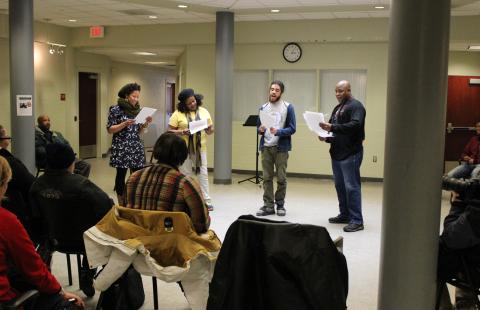What were the specific goals of this creative economy project? Describe the community development challenge or opportunity that your project was designed to address:
At the inception of this partnership, participation in Long Wharf events only reached small groups: those who purchase a ticket, those in self-selected public schools, and—key—those who feel like Long Wharf is a place where they are welcome and belong. By collaborating with the NHFPL, Long Wharf hopes to throw its doors wide open, demonstrate how the “high” art of theatre is relevant to every strata of our community, and inspire passionate conversations about our modern times. The New Haven Free Public Library provides free resources for the City’s residents. In addition to access to knowledge, it provides classes, gatherings, and events that respond to the needs of its community. However, its main currency is literature—the empowerment that learning from, and improving ourselves through, the written word affords. By creating this meaningful connection with a major regional theatre, the Library hopes that these new connections through literature will stimulate new relationships, spark courageous conversation, and foster vibrant discourse among diverse segments of the Greater New Haven community.
By aligning existing resources at each institution in a mission-driven collaboration, they create a cultural touchstone that enables its community to actively engage in discourse about timely and relevant issues affecting us today.
If the goals change over time, please describe how:
Our long term partnership includes continuous evaluation and change while our central goal of broadening access to both institutions remains in tact. Throughout each season, we listen to our ambassadors, our colleagues, and our community; reflect on the impact of our programs and community conversations and continue to outreach to new partners, neighborhoods and audiences. This all fuels the changes we make.
Who was involved in this project and what did they do? (be sure to include the partners from outside of the creative sector and how local voices were included):
This partnership was founded through the support of Co-Creating Effective and Inclusive Organizations (CEIO). In addition to grants to each organization, CEIO provides extensive resources including training, mentorship and guidance to see through the development of a true partnership.
This project’s success owes so much to so many; from our ambassadors to the librarians who talk to their patrons about the opportunity to check out a LWT Pass, to the speakers at our Community Conversations to the community participants who see theatre, discuss it and engage with their neighbors and their City.
How does this project relate to a larger community development strategy?
The City of New Haven was recently cited as “the “Creative Capital” of Connecticut” in the National Endowment for the Art’s How to Do Creative Placemaking guide (November 2016). The case study in this report shares how New Haven is approaching economic revitalization, especially in its downtown district, with artists, nonprofits arts organizations and for-profit creative entrepreneurs with its Project Storefronts initiative.
The LWT and NHFPL partnership, a nonprofit theatre arts organization and city department collaboration, is in wonderful alignment with Project Storefronts.
What projects or places, if any, inspired your approach to this creative economy project?
Components of our project were inspired by successful programs at other organizations. Our library pass program was drawn from the successful museum pass check outs at NHFPL and public libraries nationwide. As libraries are expanding their collections to include experiences as well as print materials we decided to experiment with using a similar structure to get new people to the theatre.
Secondly, our community ambassador program is inspired by a similar program started by The Foundry Theatre in New York City. We are the first to build such a program based on a partnership with a municipal organization.
